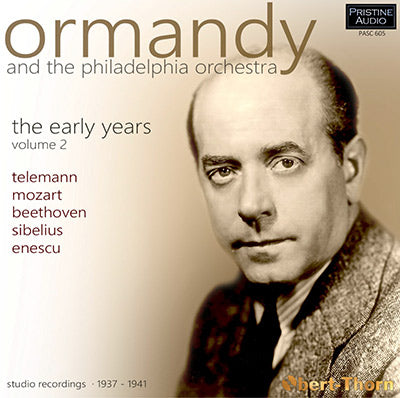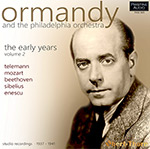
This album is included in the following sets:
This set contains the following albums:
- Producer's Note
- Full Track Listing
- Cover Art
The present release is the second in a series devoted to Eugene Ormandy’s early recordings with the Philadelphia Orchestra for the Victor and World’s Greatest Music labels from 1936 through 1942, with one additional Victor recording from 1945. While the recordings he made during this period with such legendary soloists as Rachmaninov, Kreisler, Heifetz, Feuermann, Rubinstein, Flagstad, Melchior and others have deservedly remained in the catalog for decades, this series will focus on his purely orchestral recordings, which have been rather overlooked in reissues. No remade versions of the Telemann and Mozart works in this release ever appeared during the conductor's long career, and only the Beethoven ever received an “official” extended play reissue from RCA, on a Camden LP.
Ormandy’s forays into the Baroque repertoire during this period centered around Bach transcriptions arranged by Lucien Cailliet (collected on Pristine PASC 444 and 532), although he and the orchestra did record the second and third Brandenburg Concertos anonymously for World’s Greatest Music, forthcoming in this series. The Telemann work, which is reminiscent of Bach’s more well-known Suite in B minor for Flute and Strings, is a showpiece for the Philadelphia’s principal flute, William Kincaid, who joined the orchestra in 1921 and stayed just long enough to welcome Stokowski back in 1960. In an early nod to Historically Informed Performance, an ensemble of 29 players including a harpsichord continuo was used for this recording, although some changes to the text were made in the edition employed (shortening the ending of the Ouverture, playing only the second Minuet and moving the Réjouissance to the end, probably to make it structured more like Bach's suite, which concludes with a fast Badinerie). Twice during the 1950s, Columbia re-recorded the work for an LP issue that never materialized, leaving this the sole Ormandy version.
The Mozart Divertimento which follows on our program is probably the rarest of all of Ormandy’s Philadelphia 78s due to the way it was originally packaged, as two 10-inch discs and a 12-inch disc, the last of which is almost invariably found broken in the album. It was a work to which Ormandy never returned in the studio. The Beethoven symphony is seldom found for a different reason: Ormandy had the bad timing to record it nine months before Toscanini made his own much-admired set with the BBC Symphony, which appeared on the same HMV/Victor labels. Like the Mengelberg/New York Philharmonic account which it was intended to replace in the catalog, it ran to eight sides in order to include the first movement repeat, making it somewhat less competitive to record buyers who could purchase Weingartner’s repeat-free version (made the same month as Toscanini’s) on six sides.
Sibelius was one of Ormandy’s specialties throughout his career. He had already recorded the First Symphony in Minneapolis on ten sides, but re-made the set only six years later in Philadelphia on eight longer sides in a somewhat faster (but not by much!) reading. The recordings of the three tone poems were done for an album celebrating the composer’s 75th birthday. Although he was to re-record Finlandia and The Swan of Tuonela several more times over his career, Ormandy only returned to Lemminkäinen’s Return on disc for his two complete recordings of the Lemminkäinen Suite (the earlier of which is on PASC 205). As commentator Edward Johnson points out, Ormandy adds tam-tam strokes in the nine bars before Letter P of the Return, an addition to the score also employed by Beecham in his earlier recording. The Enescu was another work Ormandy had previously recorded in Minneapolis, the earlier version on four 10-inch sides. Here, the conductor was able to fit it on two rather long 12-inch sides in a performance, like that of Lemminkäinen’s Return, of incredible speed and immense excitement.
Mark Obert-Thorn
Eugene Ormandy and The Philadelphia Orchestra: The Early Years ∙ Volume 2
CD 1 (63:16)
TELEMANN
Suite in A minor for Flute and Strings, TWV 55:a2
1. I Ouverture (4:50)
2. II Les plaisirs (2:02)
3. III Air à L’Italienne (4:04)
4. IV Menuet [II] (2:13)
5. VI Passepied I & II (1:07)
6. VII Polonaise (2:19)
7. V Réjouissance (1:33)
William Kincaid ∙ flute
Recorded 15 March 1941 ∙ Matrices: CS 062546-1, 062547-2A, 062548-1A &
062549-1 ∙ First issued on Victor 11-8120/2 in album M-890
MOZART
Divertimento No. 10 in F major for Strings and 2 Horns, K.247
8. 1st Mvt. - Allegro (5:52)
9. 2nd Mvt. - Andante grazioso (5:26)
10. 3rd Mvt. - Menuetto & Trio (3:12)
11. 4th Mvt. - Andante - Allegro assai (4:33)
Recorded 17 April 1938 ∙ Matrices: BS 022328/31 & CS 022332/3 (all Take
1) ∙ First issued on Victor 2014/5 & 15639 in album M-603
BEETHOVEN Symphony No. 1 in C major, Op. 21
12. 1st Mvt. - Adagio molto - Allegro con brio (9:35)
13. 2nd Mvt. - Andante cantabile con moto (7:12)
14. 3rd Mvt. - Menuetto: Allegro molto e vivace (3:29)
15. 4th Mvt. - Adagio - Allegro molto e vivace (5:49)
Recorded 9 January 1937 ∙ Matrices: CS 03194/9 & 04000/1 (all Take 1) ∙
First issued on Victor 14691/4 in album M-409
CD 2 (68:48)
1. SIBELIUS Finlandia, Op. 26 (7:54)
Recorded 20 October 1940 ∙ Matrices: CS 047821-2 & 047822-2 ∙ First
issued on Victor 17701 in album M-750
2.
SIBELIUS The Swan of Tuonela (No. 2 of Lemminkäinen Suite, Op. 22)
(8:30)
John Minsker ∙ English horn
Recorded 20 October 1940 ∙ Matrices: CS 047823-2 & 047824-2 ∙ First
issued on Victor 17702 in album M-750
3.
SIBELIUS Lemminkäinen’s Return (No. 4 of Lemminkäinen
Suite, Op. 22)
(5:34)
Recorded 20 October 1940 ∙ Matrices: CS 047823-2 & 047824-2 ∙ First
issued on Victor 17702 in album M-750
SIBELIUS Symphony No. 1 in E minor, Op. 39
4. 1st Mvt. - Andante, ma non troppo - Allegro energico (9:40)
5. 2nd Mvt. - Andante (ma non troppo lento) (9:26)
6. 3rd Mvt. - Scherzo: Allegro (4:46)
7. 4th Mvt. - Finale (Quasi una fantasia) (12:37)
Recorded 25 October 1941 ∙ Matrices: CS 071200-2A, 071201-1, 071202-1,
071203-1, 071204-1, 071205-1, 071206-1 & 071207-1 ∙ First issued on
Victor 18499/502 in album M-881
8.
ENESCU Romanian Rhapsody No. 1, Op. 11
(10:22)
Recorded 1 August 1941 ∙ Matrices: CS 066735-1 & 066736-2A ∙ First
issued on Victor 18201 in album M-830
Eugene Ormandy ∙ The Philadelphia Orchestra
Producer and Audio Restoration Engineer: Mark Obert-Thorn
Special thanks to Nathan Brown, Richard Kaplan and Charles Niss for
providing source material
All recordings made in the Academy of Music, Philadelphia
Cover artwork based on a photograph of Eugene Ormandy from the Tully Potter Collection
Total duration: 2hr 12:05
CD1: 63:16 CD2: 68:48

